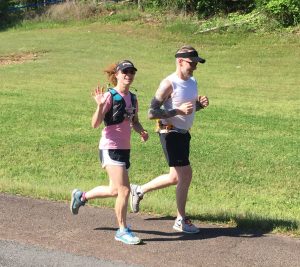 There is a common training pattern in triathlon – the long run the day after the long bike. This training strategy is usually used in Ironman distance training. The thinking is the athlete needs to ‘learn’ to run on tired legs. But this isn’t based on science.
There is a common training pattern in triathlon – the long run the day after the long bike. This training strategy is usually used in Ironman distance training. The thinking is the athlete needs to ‘learn’ to run on tired legs. But this isn’t based on science.
A Conversation:
I recently had this conversation in the parking lot after a Sunday swim. This athlete had just finished a long run.
Athlete: Tommy, do your legs shuffle along on your Sunday long run?
Me: I do my long run midweek. (I knew where this conversation was going.)
Athlete: I did a 6-hour bike ride yesterday. Today my coach has me running 2.5 hours. Man, that sucked. My legs wouldn’t move.
Me: That’s why I don’t run the day after my long bike.
Athlete: But coach says I have to learn to run on tired legs.
Me: What does that mean? From a physiology standpoint there isn’t any additional adaptation that happens when you run on tired legs versus running on fresh legs. In fact, I can make an argument that more physiological adaptations happen running on fresh legs.
What does your body “know”?:
Your body knows work – how much work you’ve done. How far you have moved your mass.
Work = F * s; where F is force applied to a mass and s is distance the mass was displaced.
When you run, you apply a force to the ground and your body moves forward a certain distance. This continues for the prescribed time or distance of the workout. At the end of the workout a certain amount of work has been done. This is what your body ‘knows’ and ‘learns’. Your body adapts to the work done.
Let’s say the athlete above normally runs 10:00 / mile on relatively fresh legs. During his 2.5 hour run he would run 15 miles. Now, let’s assume he can only manage 11:30 / mile on tired legs the day after his long bike ride. There are many reasons he’s running slower. The most common reason is his heart rate is jacked up because he’s tired so he’s running slower trying to stay in zone 2 like his coach told him to. In this case, he runs a distance of only 13 miles during his 2.5-hour run. He has run 2 miles less on his tired legs and done less work. And, I would argue, less physiological adaptations have taken place.
Intangibles:
There are two other intangible reasons I prefer my long run mid-week on relatively fresh legs. These are injury risk and durability.
Running on tired legs inevitably leads to excessive fatigue and bad form. With bad running form comes a breakdown in good running biomechanics which can lead to injury. In addition, a breakdown in running biomechanics means the athlete is practicing bad form. This bad form can become ingrained in the athlete’s muscle memory and become a permanent part of his running form. I prefer my athletes practice good running form on their long runs. Running mid-week on relatively fresh legs avoids excessive fatigue and bad form.
Durability is another aspect of running that is often overlooked. By durability I’m referring to an athlete’s joints, tendons, and muscles ability to withstand the repeated impact of the running stride. The more strides with good form an athlete takes the more opportunity his body has to adapt to the rigors of running. By running a couple more miles during his long run because he’s fresher and running faster means more miles to develop durability.
Scheduling:
Some athletes can’t do a long run mid-week due to work and family commitments. In this case, here is a strategy that could be used. If the long bike is on Saturday morning, then wait until Sunday evening to do the long run. Spend Sunday resting and recovering from the long bike then run Sunday evening. This means approximately 36 hours between the long bike and long run.
Summary:
Move your long run to mid-week. You’ll run happier, feel better, have an opportunity to practice good running form, and reduce injury risk.
